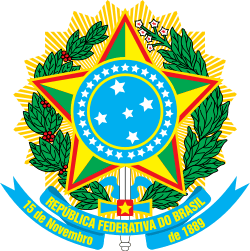Timeline of Fortaleza
The following is a timeline of the history of the city of Fortaleza, Ceará, Brazil.
Prior to 20th century
- 1649 - Fortaleza founded by Dutch.[1]
- 1810 - Town becomes capital of Ceará.[2]
- 1823 - Fortaleza attains city status.[2]
- 1846 - Lighthouse fortress built.
- 1854 - Bishopric established.[2]
- 1864 - Seminário Episcopal do Ceará (seminary) founded.
- 1872 - Population: 42,458.[3]
- 1877 - Drought.[1]
- 1887 - Instituto do Ceará (learned society} founded.[4]
- 1890 - Population: 40,902.[2]
- 1894 - Academia Cearense de Letras (literary society) founded.[4]
20th century
- 1910 - Theatro José de Alencar (theatre) opens.
- 1915 - Drought.[1]
- 1918 - Fortaleza Sporting Club founded.
- 1919 - Colégio Militar de Fortaleza established.
- 1920 - Population: 78,536
- 1928 - O Povo newspaper begins publication.[5]
- 1929 - Ceará Flying Club founded.
- 1932
- Ceará History Museum established.
- Drought.[1]
- 1933 - Ferroviário Atlético Clube (football team) formed.
- 1940 - Population: 180,901.
- 1942 - Drought.[1]
- 1946 - Regional Labor Court headquartered in city.
- 1950 - Population: 205,052.[6]
- 1957 - Tribuna do Ceará newspaper begins publication.[5]
- 1960
- Population: 514,818.
- City plan presented by Helio Modesto.[1]
- 1962 - Pirambu shantytown rally.[1]
- 1966 - Pinto Martins – Fortaleza International Airport terminal built.
- 1970 - Population: 520,175 city; 828,763 urban agglomeration.[7]
- 1971 - Integrated Development Plan for the Metropolitan Region of Fortaleza presented.
- 1973 - Castelão stadium opens.
- 1974 - Shopping Center Um in business.
- 1979 - Aldeota, Cocó, Meireles, Papicu, and Varjota development begins (approximate date).[1]
- 1980
- Ceará Museum of Image and Sound established.
- Population: 1,308,919.
- 1981
- TV Cidade Fortaleza begins broadcasting.
- Diário do Nordeste newspaper begins publication.
- 1982
- Federacao de Bairros y Favelas de Fortaleza (community organization) founded.
- Iguatemi Fortaleza shopping center in business.
- 1989 - Cocó Park established.
- 1990 - Juraci Vieira de Magalhães becomes mayor.
- 1991
- Cearah Periferia (housing organization) established.[8]
- Population: 1,765,794.[3]
- 1992 - Central de Artesanato do Ceará (craft center) built.
- 1993
- Hospital São Mateus established.
- Population: 1,846,955 (estimate).[9]
- 1997 - City divided into 7 administrative regions.(pt)
- 1999 - Dragão do Mar Center of Art and Culture inaugurated.
21st century
- 2005 - Luizianne Lins becomes mayor.
- 2007 - Sobrado of Dr. José Lourenço (building) restored.
- 2010 - Population: 2,452,185.[10]
- 2012
- Fortaleza Metro begins operating.
- October: Fortaleza 2012 municipal election held.
- 2013
- June: Protest.[11]
- Roberto Cláudio becomes mayor.
- 2014 - July: International 6th BRICS summit held in city.
- 2016 - 2 October: Fortaleza 2016 municipal election held.
See also
References
- 1 2 3 4 5 6 7 8 Gondim 2004.
- 1 2 3 4 Britannica 1910.
- 1 2 "Tabela 1.6 - População nos Censos Demográficos, segundo os municípios das capitais - 1872/2010", Sinopse do Censo Demografico 2010 (in Portuguese), Instituto Brasileiro de Geografia e Estatística, retrieved 5 September 2018
- 1 2 Alencar 1903.
- 1 2 "Brazil: Directory". Europa World Year Book 2003. Europa Publications. 2003. ISBN 978-1-85743-227-5.
- ↑ "Population of capital city and cities of 100,000 or more inhabitants". Demographic Yearbook 1955. New York: Statistical Office of the United Nations.
- ↑ United Nations Department of Economic and Social Affairs, Statistical Office (1976). "Population of capital city and cities of 100,000 and more inhabitants". Demographic Yearbook 1975. New York. pp. 253–279.
- ↑ Cabannes 1997.
- ↑ United Nations Department for Economic and Social Information and Policy Analysis, Statistics Division (1997). "Population of capital cities and cities of 100,000 and more inhabitants". 1995 Demographic Yearbook. New York. pp. 262–321.
- ↑ "2010 census". Instituto Brasileiro de Geografia e Estatística. 2010. Retrieved 30 December 2014.
- ↑ "Tear Gas Fired Outside Stadium in Brazil, but Protest Still Spreads Inside", New York Times, 19 June 2013
This article incorporates information from the Portuguese Wikipedia.
Bibliography
| Wikimedia Commons has media related to Fortaleza. |
in English
- "Fortaleza", Encyclopædia Britannica (11th ed.), New York, 1910, OCLC 14782424 – via Internet Archive
- Ernst B. Filsinger (1922), "Brazil: Fortaleza", Commercial Travelers' Guide to Latin America, Washington, DC: Government Printing Office
- Yves Cabannes (1997). "From community development to housing finance: from Mutiroes to Casa Melhor in Fortaleza, Brazil". Environment and Urbanization. London: International Institute for Environment and Development. 9.
- Linda M. P. Gondim and Laurence Hallewell (2004). "Creating the Image of a Modern Fortaleza: Social Inequalities, Political Changes, and the Impact of Urban Design". Latin American Perspectives. 31. JSTOR 3185024.
in Portuguese
- J.C.R. Milliet de Saint-Adolphe (1863), "Fortaleza", Diccionario geographico, historico e descriptivo, do imperio do Brazil (in Portuguese), Paris: J. P. Aillaud – via HathiTrust
- Álvaro Gurgel de Alencar, ed. (1903). "Fortaleza". Diccionario geographico historico e descriptivo do Estado do Ceará (in Portuguese). Louis C. Cholowieçki. p. 136+ – via HathiTrust.
- José Borzacchiello da Silva (2015). "Productive restructuring and reconfiguration of the central area of Fortaleza". Mercator (in Portuguese). Fortaleza. 14. ISSN 1984-2201 – via Scielo.

External links
- "Fortaleza, Ceará, Brazil". Heritage of Portuguese Influence (in English and Portuguese). Lisbon: Fundação Calouste Gulbenkian.
This article is issued from
Wikipedia.
The text is licensed under Creative Commons - Attribution - Sharealike.
Additional terms may apply for the media files.
